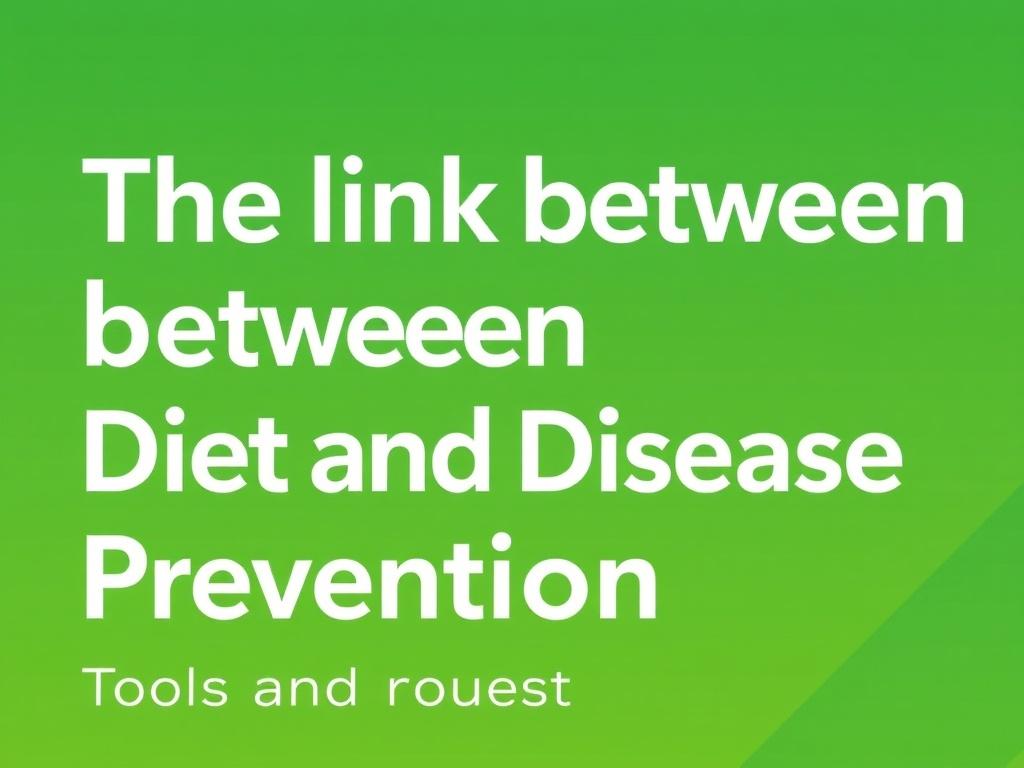Содержание
- Why Diet Matters: The Big Picture
- Evidence from Populations and Clinical Trials
- Dietary Patterns That Protect Against Disease
- Key Nutrients and Bioactive Components
- Specific Diseases: What the Evidence Suggests
- Practical Eating Strategies You Can Use Tomorrow
- Comparing Popular Diets: A Quick Guide
- Common Myths and Pitfalls
- Socioeconomic and Policy Considerations
- Behavioral Strategies for Lasting Change
- Measuring Success: What Outcomes to Watch
- Future Directions in Nutrition and Disease Prevention
- Action Plan: Practical Steps to Start Today
- Tools and Resources
- Conclusion
SQLITE NOT INSTALLED
Eating is something we do every day, but have you ever stopped to think about how the foods on your plate are quietly building — or breaking — your long-term health? This article is an invitation to take that simple daily act more seriously, without turning it into a chore. We’ll walk through why diet matters for disease prevention, how certain foods and patterns protect you, and what practical changes you can make right now. You won’t need to be a scientist to follow along; I’ll explain the big ideas in plain language and give real, usable tips you can try tomorrow.
The connection between diet and disease prevention isn’t speculation. It’s a steady accumulation of evidence from decades of research showing that eating patterns influence risk for heart disease, type 2 diabetes, many cancers, neurodegenerative conditions like Alzheimer’s, and even autoimmune and inflammatory disorders. What’s exciting is that this isn’t all about wonky lab studies — it translates into everyday choices: the fruit you pick, whether you snack on whole grains or chips, how much processed meat you consume, and whether you include legumes and leafy greens in your meals. Those choices add up, and they can steer you toward disease or away from it.
In the paragraphs that follow I’ll break down the mechanisms — inflammation, oxidative stress, blood sugar control, the gut microbiome — and show you how certain nutrients and dietary patterns interact with those mechanisms. I’ll also compare common diets, offer lists of foods to favor or limit, include a couple of useful tables to summarize the evidence, and end with practical meal ideas and steps you can take without giving up the foods you love. If you want an article to help you make smarter food decisions that actually lower your disease risk, you’re in the right place.
Why Diet Matters: The Big Picture
When we try to understand why diet matters so much, it helps to zoom out and look at the big picture. Your body is a system that depends on a steady supply of fuel and building blocks — vitamins, minerals, amino acids, fatty acids, and more. The quality and balance of these supplies affect how well the system runs. Over time, poor dietary patterns can create chronic low-grade inflammation, metabolic dysfunction, and damage to DNA and cell membranes, which are all pathways to chronic disease.
Think of your body as a garden. If you feed the soil with nutrient-rich compost and water it regularly, the garden thrives. If the soil is starved, compacted, and polluted, weeds and pests take over. Food works the same way: diets rich in whole foods — vegetables, fruits, whole grains, legumes, nuts, fish — nourish your cells and the helpful microbes in your gut. Diets high in ultraprocessed foods, refined sugars, excess salt, and unhealthy fats tend to do the opposite.
This matters not only for long-term disease risk, but also for day-to-day well-being. The same healthy pattern that reduces your risk of heart disease can improve your energy, mood, sleep, and concentration. Conversely, dietary patterns that increase disease risk often sap your day-to-day vitality first, signaling that change could pay off immediately.
How Diet Influences Disease: Key Mechanisms
You don’t need to memorize complicated biochemistry to get the point, but knowing the main mechanisms helps make sense of recommendations. Here are the primary ways diet influences disease risk:
– Inflammation: Diets high in processed foods and added sugars can trigger chronic low-level inflammation. Chronic inflammation fuels conditions like atherosclerosis, type 2 diabetes, and some cancers.
– Oxidative stress: Antioxidants from fruits, vegetables, and whole grains neutralize harmful free radicals that otherwise damage cells and DNA.
– Blood sugar and insulin: High intake of refined carbohydrates and sugary beverages promotes spikes in blood sugar and insulin resistance, a core driver of type 2 diabetes and metabolic syndrome.
– Lipid balance: Types of dietary fat matter. Diets high in saturated and trans fats raise LDL cholesterol and cardiovascular risk, while omega-3 fats lower inflammation and support heart health.
– Gut microbiome: What you eat shapes the trillions of microbes in your intestines. Fiber and polyphenol-rich foods foster beneficial bacteria that produce metabolites supporting immune and metabolic health.
– Epigenetics and gene expression: Nutrients can influence which genes are turned on or off. This is part of why diet can change disease risk even when genetic predisposition exists.
Each of these pathways is a thread that connects dietary decisions to real outcomes like heart attacks, strokes, and cancers. The beauty is that many protective foods work across multiple pathways simultaneously — for example, leafy greens are anti-inflammatory, antioxidant-rich, and support healthy blood pressure.
Evidence from Populations and Clinical Trials

Evidence comes in two major flavors: population studies (epidemiology) that observe large groups over time, and clinical trials that test specific interventions. Both have strengths and limitations. Observational studies can suggest strong associations but can’t conclusively prove cause and effect. Randomized controlled trials can test causality but are often short-term or limited in scope.
Still, the picture that emerges is consistent. Large cohorts show lower rates of cardiovascular disease, certain cancers, and diabetes in people who follow plant-forward diets, Mediterranean-style patterns, or diets rich in whole grains and vegetables. Clinical trials such as the PREDIMED study in Spain found that a Mediterranean diet supplemented with nuts or extra virgin olive oil significantly reduced cardiovascular events in high-risk individuals. Trials also show that weight loss through diet reduces blood sugar in type 2 diabetes and can, in many cases, lead to remission.
The consistency across different populations and methodologies adds confidence: diet matters, and meaningful change often leads to measurable health benefits.
Diseases Most Affected by Diet
While diet plays a role in nearly every chronic condition to some degree, certain diseases are especially influenced by what you eat. Here are the major ones to keep in mind:
– Cardiovascular disease (heart attacks, strokes)
– Type 2 diabetes and metabolic syndrome
– Certain cancers, especially colorectal, breast, and gastric cancers
– Obesity and its complications
– Neurodegenerative diseases such as Alzheimer’s
– Nonalcoholic fatty liver disease (NAFLD)
– Some autoimmune and inflammatory conditions
Each of these has unique dietary considerations, but many recommendations overlap: favor whole foods, minimize ultraprocessed items, prioritize plant-based fiber, and choose healthy fats.
Dietary Patterns That Protect Against Disease
It’s easier and more effective to think in terms of overall dietary patterns than single “superfoods.” Here are patterns with the best evidence for disease prevention:
Mediterranean Diet
The Mediterranean diet emphasizes vegetables, fruits, legumes, whole grains, nuts, fish, olive oil, and moderate wine. It is associated with lower risks of cardiovascular disease, some cancers, and cognitive decline. The diet’s benefits come from favorable fats (olive oil, nuts), fiber, antioxidants, and anti-inflammatory compounds.
DASH Diet (Dietary Approaches to Stop Hypertension)
Original designed to lower blood pressure, the DASH diet is rich in fruits, vegetables, low-fat dairy, whole grains, and limited in sodium and saturated fat. It reduces blood pressure and is associated with lower cardiovascular risk.
Plant-Forward and Vegetarian Diets
Diets that prioritize plant foods (including vegetarian and vegan patterns) are linked to lower risks of heart disease, hypertension, and type 2 diabetes. Careful planning ensures adequate protein, B12, iron, and omega-3 intake.
Whole-Food, Low-Processed Diets
A simple, evidence-backed pattern is to minimize ultraprocessed foods: fast food, sugary drinks, packaged snacks, and ready meals. These items often deliver excess calories, salt, unhealthy fats, and additives that can harm metabolic health.
Low-Carb and Mediterranean-Style Low-Carb Variants
Lower-carbohydrate diets can help control blood sugar and promote weight loss in the short term. When focused on high-quality fats and vegetables (rather than processed meats and refined fats), they can be part of a disease-prevention strategy, particularly for people with insulin resistance.
Key Nutrients and Bioactive Components
To make smart choices, it helps to know which foods supply the protective agents your body needs. Below is a table that summarizes important nutrients, common food sources, and their protective effects.
| Nutrient/Component | Common Sources | Protective Effects |
|---|---|---|
| Dietary Fiber | Whole grains, legumes, fruits, vegetables, nuts | Improves gut health, reduces cholesterol, stabilizes blood sugar, lowers colorectal cancer risk |
| Omega-3 Fatty Acids (EPA/DHA) | Fatty fish, algae supplements, walnuts (ALA) | Reduces inflammation, lowers triglycerides, supports heart and brain health |
| Monounsaturated Fats | Olive oil, avocados, nuts | Improves lipid profile and reduces cardiovascular risk |
| Polyphenols and Antioxidants | Berries, tea, coffee, dark chocolate, colorful vegetables | Reduce oxidative stress and inflammation; support vascular and brain health |
| Vitamins (D, C, E, Folate) | Fatty fish, citrus, leafy greens, fortified foods | Support immune function, DNA repair, and reduce disease risk in deficiency states |
| Minerals (Potassium, Magnesium, Calcium) | Bananas, leafy greens, dairy, legumes | Regulate blood pressure, bone health, and metabolic processes |
| Probiotics and Prebiotics | Yogurt, kefir, fermented vegetables; garlic, onions, bananas, inulin-rich foods | Support gut microbiome balance, immunity, and metabolic health |
Antinutrients and How to Think About Them
You’ll hear the term “antinutrients” (e.g., phytic acid, oxalates) thrown around as reasons to avoid certain plant foods. It’s important to keep perspective. For most people, the benefits of legumes, whole grains, nuts, and dark leafy greens far outweigh any theoretical downsides of antinutrients. Proper preparation — soaking, fermenting, cooking — reduces these compounds and boosts nutrient availability.
Specific Diseases: What the Evidence Suggests
Let’s look at specific conditions and the dietary strategies that most consistently reduce risk.
Cardiovascular Disease
Heart disease is the leading cause of death worldwide, and diet is one of the most powerful modifiable risk factors. Diets low in saturated fat and trans fat, rich in unsaturated fats, high in fiber, and low in ultraprocessed foods reduce LDL cholesterol, improve blood pressure, and reduce inflammation. Nuts, olive oil, fatty fish, whole grains, and legumes are cardiovascular superstars.
Practical rules:
- Replace butter and hydrogenated oils with olive oil or other vegetable oils.
- Eat fish (especially fatty varieties) twice a week.
- Choose whole grains instead of refined grains.
- Limit processed meats and high-sodium packaged foods.
Type 2 Diabetes
Type 2 diabetes is driven by insulin resistance and weight gain. Diets that stabilize blood sugar — high in fiber, moderate in healthy fats and protein, and low in refined carbohydrates and sugary drinks — reduce incidence and help with management. Weight loss of even 5–10% can drastically improve blood sugar control.
Practical rules:
- Limit sugar-sweetened beverages and desserts.
- Favor whole fruits over juices.
- Pair carbohydrates with protein or healthy fat to slow glucose rise.
Cancer
Diet influences cancer risk through multiple mechanisms — obesity, inflammation, carcinogens from processed foods, and deficiencies in protective nutrients. Strong evidence links high fiber intake to lower colorectal cancer risk and suggests that fruits and vegetables protect against certain cancers. Red and processed meat consumption is associated with higher colorectal cancer risk; limiting these is prudent.
Practical rules:
- Eat a variety of colorful vegetables and fruits daily.
- Limit processed and red meats; choose plant proteins often.
- Keep body weight in a healthy range.
Neurodegenerative Disease
Growing evidence indicates that the Mediterranean diet and diets rich in omega-3s, antioxidants, and polyphenols may lower the risk of cognitive decline and Alzheimer’s disease. Vascular health is tightly linked to brain health, so the same strategies that protect the heart often protect the brain.
Practical rules:
- Prioritize fish, nuts, blueberries, leafy greens, and olive oil.
- Avoid excessive refined sugars and processed foods.
Obesity and Metabolic Syndrome
Obesity is a major driver of many chronic diseases. Diets that are high in energy density (calories per volume), sugary drinks, and processed snack foods promote overconsumption. Emphasize high-fiber, low-energy-density foods — vegetables, soups, salads, and lean proteins — to maintain a healthy weight. Behavior change, portion control, and environmental changes are often necessary to sustain weight loss.
Practical Eating Strategies You Can Use Tomorrow
Changing how you eat doesn’t require perfection; it requires small, sustainable moves. Below are practical strategies that produce benefits without making your life miserable.
Simple Swaps That Add Up
Here’s a quick list of swaps that are easy to implement:
- White bread → Whole-grain bread or sprouted grain bread
- Soda → Sparkling water with lemon
- Fried potatoes → Roasted sweet potatoes or a baked potato with olive oil
- Butter on toast → Avocado or a light spread of olive oil
- Processed snack bars → Nuts and fruit
- Ice cream → Greek yogurt with berries
These small changes reduce refined carbs, increase fiber, and improve fat quality — three big wins for disease prevention.
Meal Templates for Balanced Eating
Rather than counting calories obsessively, use these templates to build balanced plates:
- Half your plate vegetables (raw, steamed, or roasted)
- One-quarter lean protein (fish, poultry, legumes, tofu)
- One-quarter whole grains or starchy vegetables (brown rice, quinoa, sweet potato)
- Add healthy fat (olive oil, avocado, nuts) and a piece of fruit or yogurt for dessert if desired
This template makes it easy to get fiber, protein, and healthy fats at every meal — key ingredients for stable blood sugar and satiety.
Snack Smarter
Snacks are often where ultraprocessed calories creep in. Choose snacks that combine protein and fiber to keep you full: apple slices with almond butter, Greek yogurt and berries, hummus with carrots, or a small handful of nuts and dried fruit.
Comparing Popular Diets: A Quick Guide
Different diets can work for different people. The table below summarizes several popular patterns and how they perform for disease prevention.
| Diet | Core Features | Disease Prevention Strengths |
|---|---|---|
| Mediterranean | Olive oil, fish, vegetables, fruits, nuts, moderate wine | Strong evidence for cardiovascular and cognitive protection |
| DASH | Low sodium, fruits, vegetables, low-fat dairy | Excellent for blood pressure and heart disease risk |
| Plant-Based/Vegetarian | Emphasizes plant foods; may include dairy/eggs | Lower cardiovascular and diabetes risk when well-planned |
| Keto/Very Low-Carb | Very low carbs, high fat, moderate protein | Can improve blood sugar and weight short-term; long-term effects depend on food quality |
| Traditional Low-Fat | Less dietary fat, more carbs | Mixed evidence; benefits depend on whether carbs are whole or refined |
The key is food quality. A high-fat Mediterranean-style approach built on vegetables, nuts, and fish beats a high-fat pattern based on processed meats and fried foods every time.
How to Personalize Your Diet
Everyone is different: genetics, lifestyle, culture, and budget matter. Use these principles to personalize:
– Start with a protective pattern (Mediterranean/DASH/plant-forward).
– Adjust macronutrient balance to suit satiety and health goals.
– Check for food intolerances or allergies.
– Seek professional guidance for specific conditions (e.g., diabetes, kidney disease).
– Make changes gradually so they stick.
Common Myths and Pitfalls
There are lots of myths that muddy the waters. Here are a few to set straight:
Myth: All fats are bad
No. Unsaturated fats (olive oil, nuts, fatty fish) are protective. Trans fats and excessive saturated fats from processed foods are the ones to avoid.
Myth: Carbs are evil
No. Whole-food carbohydrates (whole grains, fruits, legumes) are beneficial. Highly refined carbs and sugary drinks are the problem.
Myth: Supplements can replace food
Not usually. Whole foods contain complex combinations of nutrients and phytochemicals that supplements can’t fully mimic. Supplements can be helpful in targeted situations (e.g., vitamin B12 for vegans, vitamin D in deficiency), but they’re not a substitute for a healthy diet.
Myth: You need to be perfect
Perfection isn’t required. Consistent, good-enough choices over time are what protect against disease. Small improvements sustained over years produce big benefits.
Socioeconomic and Policy Considerations
It’s important to acknowledge that access to healthy food is not equal. Food deserts, income inequality, and marketing of unhealthy processed foods make it hard for many people to follow protective diets. Policy solutions — subsidizing fruits and vegetables, regulating marketing aimed at children, improving school meals, and incentivizing whole-food production — can have large public health benefits. Individual advice must be realistic within social and economic contexts.
How Food Environment Shapes Choices
Where you live affects what you eat. Neighborhood stores, the presence of fast-food outlets, and work schedules all influence dietary patterns. Small policy changes, like making fresh produce cheaper and more available, have outsized effects on public health compared to individual-level advice alone.
Behavioral Strategies for Lasting Change
Changing diet is as much about behavior as it is about knowledge. Here are evidence-backed strategies that help:
– Set specific, measurable goals (e.g., “Add one vegetable to dinner five times a week”).
– Use planning and prep: batch-cook grains, chop vegetables, pack lunches.
– Make the environment supportive: keep fruit visible, remove tempting snacks.
– Focus on routine: consistent meal times can stabilize appetite and choices.
– Seek social support: family, friends, or community groups increase adherence.
– Monitor progress, but be flexible: use habits rather than rigid rules.
Recipes and Meal Ideas
Here are a few simple, protective meals that are quick to prepare:
- Lunch grain bowl: quinoa, roasted chickpeas, spinach, cherry tomatoes, avocado, olive oil, lemon
- Breakfast: Greek yogurt with berries, walnuts, and a sprinkle of oats
- Dinner: Baked salmon, steamed broccoli, and a sweet potato
- Snack: Hummus with carrot sticks and a small apple
These are balanced, satisfying, and use whole foods that support long-term health.
Measuring Success: What Outcomes to Watch

When you change your diet, look for meaningful indicators of improved health beyond weight:
– Blood pressure and resting heart rate
– Fasting glucose or HbA1c for blood sugar control
– Blood lipids (LDL, HDL, triglycerides)
– Energy, sleep quality, and mood
– Digestion and bowel regularity
– Waist circumference and body composition
Regular check-ins with your healthcare provider can help track objective measures and ensure your nutritional needs are met.
When to Seek Professional Help
If you have chronic conditions like diabetes, kidney disease, or complex nutritional needs, see a registered dietitian or physician before making major changes. They can tailor dietary plans to medications, lab values, and personal preferences.
Future Directions in Nutrition and Disease Prevention
Nutrition science is evolving rapidly. Future areas of focus include personalized nutrition based on genetics and microbiome, more precise understanding of food processing effects, and better strategies to scale healthy food access. While some personalized claims are premature, one clear trend is that more variety and whole-food emphasis will remain central to recommendations.
New technologies, like apps that help with meal planning and nutrient tracking, can support behavior change. At the same time, policy efforts and food industry shifts toward healthier formulations are essential to make the healthy choice the easy choice at scale.
A Note About Sustainability
Increasingly, experts recommend aligning personal health with planetary health. Diets that are mostly plant-based, lower in red meat, and that minimize food waste are not only good for your body but also for the environment. Choosing sustainable options can be both an ethical and a health-positive decision.
Action Plan: Practical Steps to Start Today
If you’re ready to act, here’s a simple playbook to get started:
1. Add one extra serving of vegetables to your day for the next week. Track it.
2. Replace sugary drinks with water or unsweetened tea.
3. Choose whole grains in two meals this week (oatmeal, brown rice, whole-wheat bread).
4. Swap one red or processed meat meal for a fish or legume-based meal.
5. Prep a healthy snack (nuts and fruit or hummus and veggies) to avoid impulse choices.
These small, sustainable shifts create momentum. After a month, reassess and add another change.
Quick Troubleshooting
If you struggle, try these fixes:
- Not enough time? Batch-cook on weekends or double recipes for leftovers.
- Budget concerns? Frozen vegetables and canned beans are nutritious and affordable.
- Boredom? Try recipes from different cuisines that emphasize vegetables and legumes — Mexican, Mediterranean, Indian.
Tools and Resources

There are many resources to support healthier eating:
- Registered dietitians for personalized plans
- Simple apps for tracking meals and goals
- Community cooking classes and online recipe sites focused on whole foods
- Local markets and community-supported agriculture (CSA) for fresh produce
These tools can reduce friction and make change feel less daunting.
Conclusion
Diet is a powerful lever for preventing disease and promoting long-term well-being. The evidence is clear that dietary patterns rich in whole plant foods, healthy fats, and lean proteins, and low in processed foods and added sugars, reduce risk for cardiovascular disease, type 2 diabetes, certain cancers, and cognitive decline. You don’t need a perfect diet to benefit — small, consistent changes matter a lot. Focus on patterns rather than perfection: prioritize vegetables, whole grains, legumes, nuts, olive oil, and fish; limit processed foods, sugary beverages, and excessive red or processed meats; plan meals, make simple swaps, and tailor recommendations to your life and culture. Combine personal efforts with awareness of the larger food environment and policy solutions to make healthy eating more accessible for everyone. Start with one change today, and let it compound into better health over the years.





